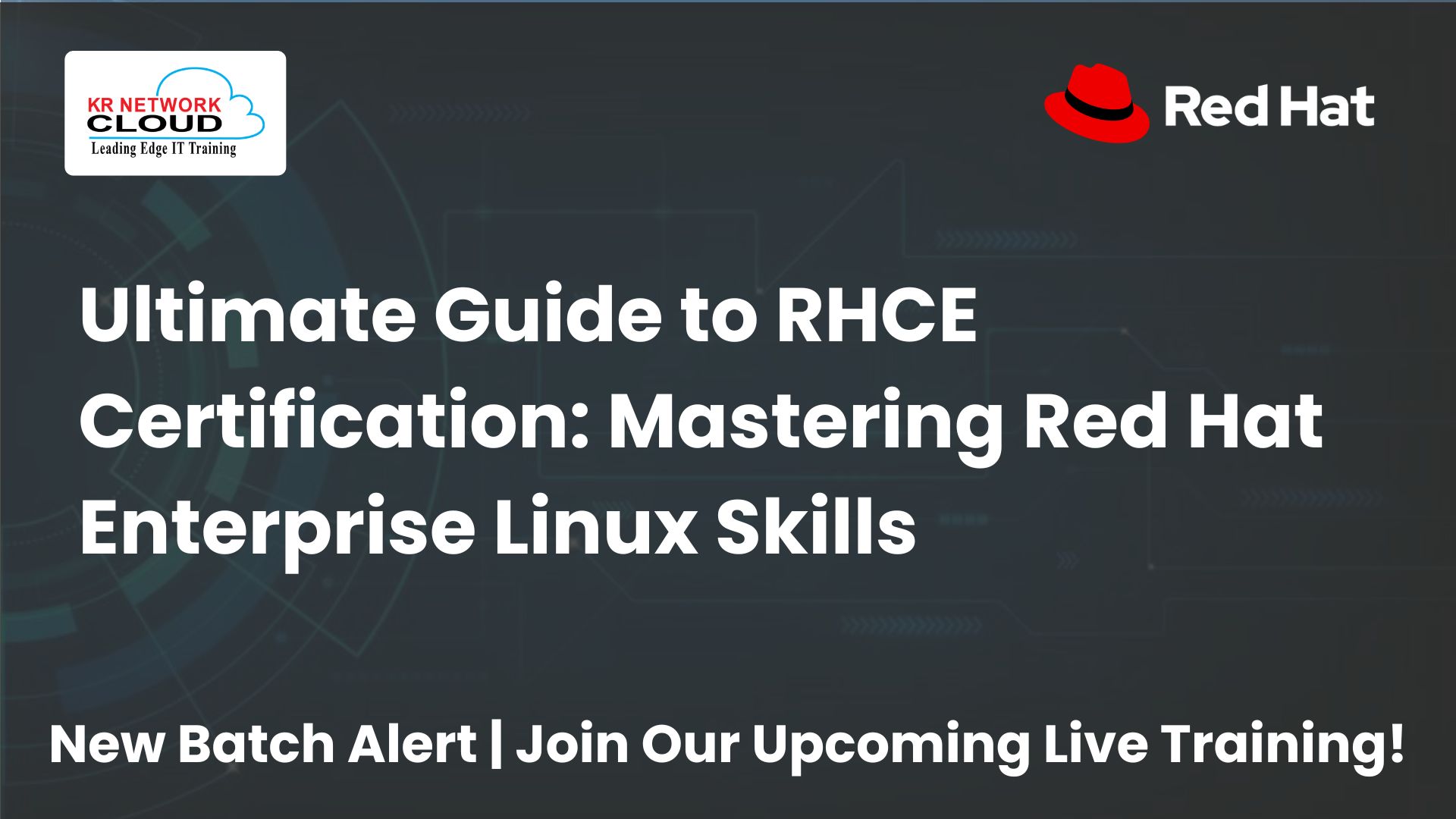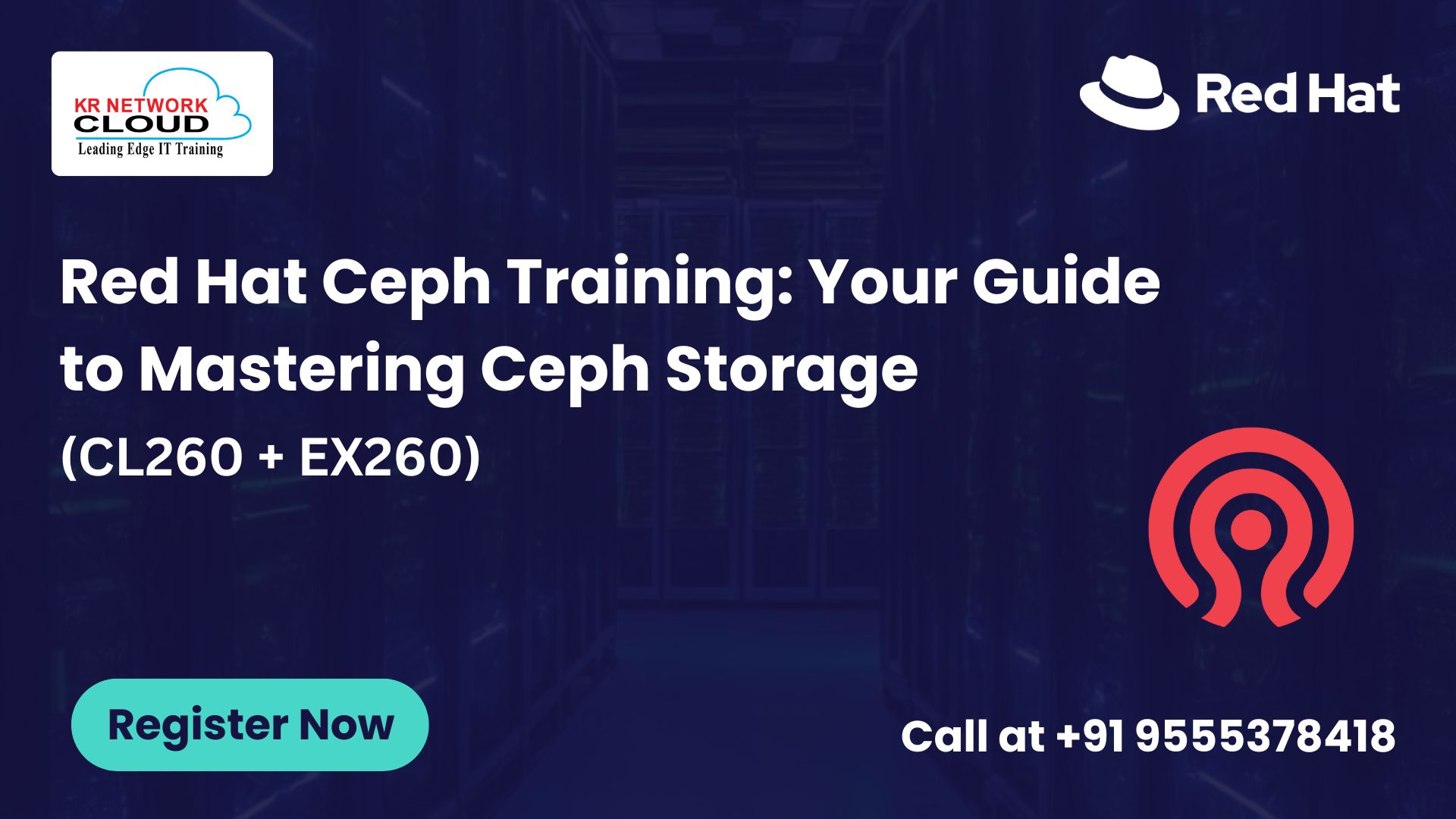Empower Your Cloud-Native Journey: Mastering Red Hat OpenShift Certification and Administration

- KR NETWORK CLOUD
- August 3, 2025
Introduction to Red Hat OpenShift: A Cloud-Native Powerhouse
In today’s rapidly evolving tech landscape, Red Hat OpenShift certification has emerged as a leading platform for container orchestration, built on the robust foundation of Kubernetes. It empowers organizations to develop, deploy, and manage applications seamlessly across hybrid and multi-cloud environments, making it a cornerstone for cloud-native innovation. For IT professionals—whether system administrators, developers, or DevOps engineers—mastering Red Hat OpenShift through OpenShift certification is a game-changer. The Red Hat Certified Specialist in OpenShift Administration (EX280) validates your ability to manage OpenShift clusters in production, positioning you as a sought-after expert in cloud-native technologies.
This comprehensive 3000-word blog is your ultimate guide to OpenShift training, diving deep into the OpenShift course (DO280: Red Hat OpenShift Administration II). We’ll explore critical skills like exposing non-HTTP/SNI applications, enabling developer self-service, managing Kubernetes operators, securing applications, and performing OpenShift certification updates. You’ll also find insights into OpenShift pricing, practical strategies to learn OpenShift, and how Red Hat training prepares you for the EX280 exam and a thriving career in OCP OpenShift administration. Whether you’re just starting or aiming to level up, this human-optimized guide will empower your cloud-native journey.
Why Red Hat OpenShift Certification Matters
The Red Hat OpenShift certification is a globally recognized credential that demonstrates your expertise in managing containerized applications in enterprise environments. As businesses adopt cloud-native workflows to stay competitive, professionals skilled in OCP OpenShift are in high demand for roles like platform engineer, DevOps specialist, and cloud architect. The OpenShift course DO280 equips you with hands-on skills to configure, secure, and maintain production-grade OpenShift clusters, ensuring you’re ready for real-world challenges.
Benefits of OpenShift Certification
Career Advancement: Certified professionals stand out in the job market, with opportunities in industries like finance, healthcare, and technology.
Hands-On Expertise: Red Hat training emphasizes practical labs, covering tasks like configuring Kubernetes operators and managing cluster updates.
Global Recognition: The Red Hat Certified OpenShift Administrator credential is respected worldwide, boosting your professional credibility.
Flexible Learning Options: Choose from in-classroom, virtual, or self-paced OpenShift training to fit your schedule and learning style.
For those wondering about OpenShift pricing, training costs vary by region and provider. Authorized partners like Koenig Solutions, Global Knowledge, or Red Hat directly offer the DO280 course, typically priced between $2,000 and $4,000, depending on the delivery format. Check Red Hat’s official website or training partners for precise OpenShift pricing details.
Navigating the OpenShift Training Landscape: DO280 Overview
The Red Hat OpenShift Administration II: Configuring a Production Cluster (DO280) course is designed for platform administrators and is a key step toward earning the EX280 certification. It covers advanced administration tasks, from networking and security to cluster maintenance. Below, we dive into the key modules (5–9) from the course, providing actionable insights to help you learn OpenShift and excel in OCP OpenShift administration certification.
Module 5: Exposing Non-HTTP/SNI Applications
Many modern applications, such as databases or messaging systems, rely on non-HTTP or non-SNI (Server Name Indication) protocols. This module teaches you how to configure Red Hat OpenShift to expose these workloads to external clients, ensuring flexibility and scalability.
Load Balancer Services
Load balancer services distribute traffic across multiple pods, ensuring high availability for non-HTTP applications. In the Guided Exercise: Load Balancer Services, you’ll learn to:
Create a load balancer service using the oc CLI to expose TCP-based applications.
Integrate with cloud provider load balancers (e.g., AWS ELB or Azure Load Balancer) or assign external IPs.
Test connectivity to verify external access to the application.
This skill is critical for deploying services like PostgreSQL or RabbitMQ in OpenShift clusters.
Multus Secondary Networks
Multus, a multi-network plugin, allows pods to connect to multiple network interfaces, ideal for high-performance computing or isolated traffic. The Guided Exercise: Multus Secondary Networks covers:
Installing and configuring Multus CNI plugins in OpenShift.
Attaching secondary networks to pods for specialized use cases.
Validating network connectivity using diagnostic tools like ping or netcat.
Lab: Expose Non-HTTP/SNI Applications
The lab challenges you to deploy a sample non-HTTP application, configure a load balancer service, and attach a secondary network using Multus. This hands-on exercise prepares you to handle diverse networking requirements in production OpenShift environments.
Module 6: Enabling Developer Self-Service
Red Hat OpenShift certification excels at empowering developers to manage their projects independently while maintaining administrative oversight. This module focuses on configuring clusters to support safe, self-service provisioning.
Project and Cluster Quotas
Quotas ensure fair resource allocation by limiting CPU, memory, and storage usage across projects. The Guided Exercise: Project and Cluster Quotas teaches you to:
Define quotas using the oc create quota command.
Monitor resource usage via the OpenShift web console or oc describe quota.
Adjust quotas dynamically to optimize cluster performance.
Per-Project Resource Constraints: Limit Ranges
Limit ranges enforce minimum and maximum resource boundaries within a project, preventing resource-intensive applications from destabilizing the cluster. The Guided Exercise: Per-Project Resource Constraints: Limit Ranges includes:
Setting default, minimum, and maximum CPU/memory limits for containers.
Applying limit ranges to ensure compliance in multi-tenant environments.
Testing limit range policies to maintain cluster stability.
Project Template and Self-Provisioner Role
Project templates streamline project creation with predefined settings, while the self-provisioner role enables developers to create their own projects. The Guided Exercise: Project Template and Self-Provisioner Role covers:
Customizing project templates with default quotas, roles, and resources.
Assigning the self-provisioner role to users or groups using RBAC policies.
Testing self-service project creation to ensure seamless developer workflows.
This module equips you to balance developer autonomy with governance, a critical skill for enterprise OCP OpenShift certification deployments.
Module 7: Managing Kubernetes Operators
Kubernetes operators simplify the management of complex applications by automating tasks like scaling, upgrades, and backups. This module explores their role in Red Hat OpenShift and how to leverage the Operator Lifecycle Manager (OLM).
Kubernetes Operators and the Operator Lifecycle Manager
The Quiz: Kubernetes Operators and the Operator Lifecycle Manager tests your understanding of:
How operators encapsulate application-specific logic for automation.
The role of OLM in installing, updating, and managing operators.
Installing Operators
The Guided Exercise: Install Operators with the Web Console and Guided Exercise: Install Operators with the CLI teach you to:
Browse and install operators from the Embedded OperatorHub in the OpenShift web console.
Use the oc CLI to deploy custom operators from external catalogs.
Verify operator installation and functionality using oc get csv.
Lab: Manage Kubernetes Operators
The lab requires you to install a sample operator (e.g., Prometheus or MongoDB), configure it, and troubleshoot issues. This hands-on experience reinforces practical skills for managing Kubernetes operators in production environments.
Module 8: Application Security
Security is paramount in Red Hat OpenShift certification, especially for applications requiring elevated privileges or access to Kubernetes APIs. This module covers advanced security configurations to ensure robust application security.
Security Context Constraints (SCCs)
SCCs define pod permissions, ensuring applications run with minimal privileges. The Guided Exercise: Control Application Permissions with Security Context Constraints teaches you to:
Create and customize SCCs to restrict capabilities like privileged containers.
Assign SCCs to service accounts for specific applications.
Validate SCC enforcement using oc describe scc.
Allowing Application Access to Kubernetes APIs
Some applications need to interact with the Kubernetes API for advanced functionality, such as monitoring or orchestration. The Guided Exercise: Allow Application Access to Kubernetes APIs covers:
Configuring RBAC policies to grant API access to service accounts.
Testing API interactions using tools like curl or custom application code.
Ensuring secure and limited API permissions to prevent misuse.
Cluster and Node Maintenance with Kubernetes Cron Jobs
Cron jobs automate recurring maintenance tasks, such as log rotations or backups. The Guided Exercise: Cluster and Node Maintenance with Kubernetes Cron Jobs includes:
Creating and scheduling cron jobs using oc create cronjob.
Monitoring job execution with oc get jobs and troubleshooting failures.
Optimizing cron jobs for cluster efficiency and resource usage.
Lab: Application Security
The lab integrates these concepts, requiring you to secure an application with SCCs, enable API access, and automate maintenance tasks using cron jobs. This exercise ensures you can implement robust application security practices in OpenShift Certification.
Real-World Applications of OpenShift Skills
The skills gained from OpenShift training are directly applicable to real-world scenarios:
Enterprise Deployments: Configure secure, multi-tenant OpenShift clusters for industries like finance or healthcare.
DevOps Pipelines: Enable developer self-service to streamline CI/CD workflows.
Application Security: Implement SCCs and RBAC to protect sensitive applications.
Cluster Maintenance: Automate tasks and perform OpenShift updates to ensure reliability and compliance.
Conclusion
Empowering your cloud-native journey with Red Hat OpenShift certification is a transformative step toward becoming a leader in container orchestration. The OpenShift course DO280 equips you with advanced skills to manage OCP OpenShift clusters, from exposing non-HTTP/SNI applications to securing applications and performing OpenShift updates. With Red Hat training, you gain hands-on expertise, access to a vibrant community, and a globally recognized credential. Whether you’re exploring OpenShift pricing, seeking to learn OpenShift, or preparing for the EX280 exam, this guide provides a clear roadmap to success. Start your OpenShift Certification today and unlock a world of opportunities in cloud-native innovation!
Watch out the video: Click Here
FAQs
1. What is Red Hat OpenShift, and why is it important?
Answer: Red Hat OpenShift certification is an enterprise-grade container orchestration platform built on Kubernetes, designed to simplify the development, deployment, and management of applications across hybrid and multi-cloud environments. It’s important because it enables organizations to scale applications efficiently, enhance developer productivity, and ensure robust security. Mastering OCP OpenShift certification through Red Hat training equips IT professionals with skills to manage cloud-native workloads, making them highly valuable in industries like finance, healthcare, and technology.
2. What is the Red Hat OpenShift certification, and who should pursue it?
Answer: The Red Hat OpenShift certification, such as the Red Hat Certified Specialist in OpenShift Administration (EX280), validates your ability to configure, manage, and troubleshoot OpenShift clusters in production environments. It’s ideal for system administrators, DevOps engineers, and developers aiming to excel in cloud-native technologies. Pursuing OpenShift certification demonstrates expertise in OCP OpenShift, boosting career prospects in roles like platform engineer or cloud architect.
3. What does the OpenShift course (DO280) cover?
Answer: The OpenShift course DO280 (Red Hat OpenShift Administration II: Configuring a Production Cluster) focuses on advanced administration tasks. It covers:
- Exposing non-HTTP/SNI applications using load balancer services and Multus secondary networks.
- Enabling developer self-service with project quotas, limit ranges, and self-provisioner roles.
- Managing Kubernetes operators using the Operator Lifecycle Manager (OLM).
- Securing applications with Security Context Constraints (SCCs), Kubernetes API access, and cron jobs.
- Performing OpenShift updates and detecting deprecated APIs.
The course includes hands-on labs to prepare you for the EX280 exam and real-world OpenShift administration.
4. How can I start learning OpenShift?
Answer: To learn OpenShift, follow these steps:
- Enroll in Red Hat Training: Start with DO180 (OpenShift Administration I) for beginners, followed by DO280 for advanced skills.
- Use the Red Hat Developer Sandbox: Practice OCP OpenShift features like networking and Kubernetes operators in a free, cloud-based environment.
- Take a Skills Assessment: Use Red Hat’s free assessment to identify your readiness for OpenShift training.
- Join the Community: Engage with the Red Hat Learning Community for resources and peer support.
- Study the CLI: Master the oc command-line tool for efficient cluster management.
5. What is the cost of OpenShift training and certification?
Answer: OpenShift pricing for training varies by provider and format. The OpenShift course DO280 typically costs $2,000–$4,000, depending on whether you choose in-classroom, virtual, or self-paced Red Hat training. The EX280 exam fee is approximately $400–$600, depending on the region. For precise OpenShift pricing, visit Red Hat’s training page or check with authorized partners like Koenig Solutions or Global Knowledge.
6. What is the pricing for deploying Red Hat OpenShift?
Answer: OpenShift pricing for platform deployment depends on the model:
- Self-Managed OpenShift: Starts at ~$0.076/hour for a 4vCPU, 3-year contract, varying by node configuration and subscription (e.g., OpenShift Container Platform).
- Fully Managed OpenShift: Services like Red Hat OpenShift on AWS (ROSA) or Azure Red Hat OpenShift (ARO) follow cloud provider pricing, typically $0.10–$0.20/hour per node. For detailed pricing, visit Red Hat’s pricing page.
7. How long does it take to prepare for the OpenShift certification exam (EX280)?
Answer: Preparation time for the Red Hat OpenShift certification (EX280) varies based on your experience. For those with Kubernetes or Linux administration knowledge, completing the OpenShift course DO280 (4–5 days) and 1–2 months of hands-on practice in the Red Hat Developer Sandbox is sufficient. Beginners may need 3–4 months, including DO180 and DO280, plus additional practice. Regular use of the oc CLI and studying OCP OpenShift concepts like Kubernetes operators and security accelerate preparation.
8. What are Kubernetes operators, and why are they important in OpenShift?
Answer: Kubernetes operators are software extensions that automate complex application management tasks, such as scaling, upgrades, and backups, in Red Hat OpenShift. They encapsulate application-specific logic, making it easier to deploy and manage stateful applications like databases. The Operator Lifecycle Manager (OLM) in OpenShift simplifies operator installation and updates. Learning to manage Kubernetes operators through OpenShift training certification is critical for maintaining production-grade applications.
9. How does OpenShift support non-HTTP/SNI applications?
Answer: Red Hat OpenShift supports non-HTTP/SNI applications (e.g., TCP-based services like databases) through:
- Load Balancer Services: Distribute traffic across pods using cloud provider load balancers or external IPs.
- Multus Secondary Networks: Enable pods to connect to multiple network interfaces for specialized traffic, using Multus CNI plugins. The DO280 OpenShift course includes guided exercises and labs to configure these features, ensuring you can expose diverse workloads in OCP OpenShift.
10. What is developer self-service in OpenShift, and how is it configured?
Answer: Developer self-service in Red Hat OpenShift allows developers to create and manage projects independently, reducing administrative overhead. It’s configured through:
- Project and Cluster Quotas: Limit CPU, memory, and storage to ensure fair resource allocation.
- Limit Ranges: Enforce minimum and maximum resource boundaries for containers.
- Project Templates and Self-Provisioner Role: Streamline project creation with predefined settings and grant developers the ability to create projects via RBAC. The DO280 OpenShift course teaches these configurations, enabling multi-tenant environments with governance.






